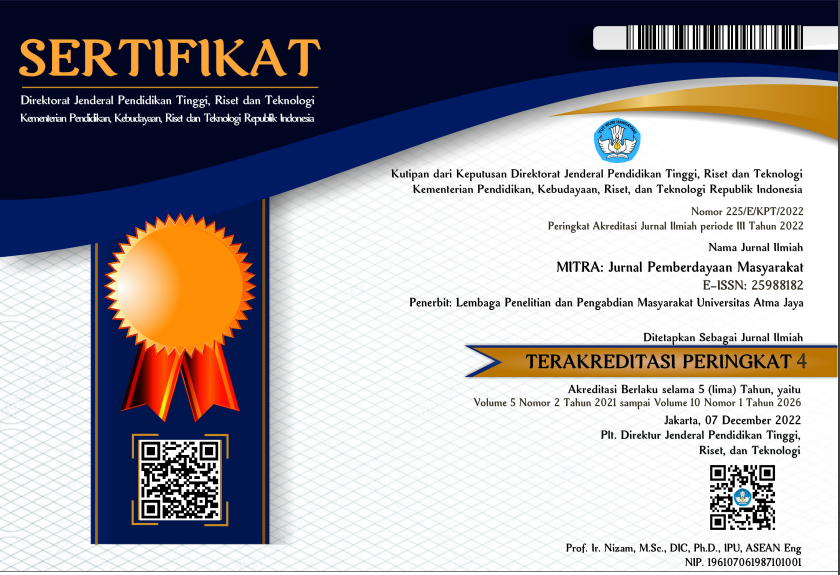Enrichment of Anti Hoax Competency among Secondary School Students
DOI:
https://doi.org/10.25170/mitra.v6i2.2555Keywords:
hoax, science communication, workshop, critical thinkingAbstract
Hoax and misinformation are common occurrences in the current era of social media. Nurturing critical thinking is necessary to combat the proliferation of hoaxes, especially in the younger generation. In this activity, we conducted a workshop for high school students and teachers to build awareness of hoaxes and how to identify them. This in-person workshop was held at Canisius College High School in a three-hour session. After taking part in the workshop, participants were expected to be able to explain the definition of a hoax, explain why hoaxes exist and are spread out among the community, and analyze the credibility of new information. For this purpose, the workshop consisted of three sessions. In the first session, the facilitators walked all participants through a lively discussion on what hoaxes are and how they get passed on from one person to another. In the second session, we introduced the concept of credibility to the participants. In the final session, the participants practiced evaluating the credibility of news. All sessions were delivered as paired or group discussions using authentic articles or postings from various social media platforms. The evaluation survey at the end of the activity showed that the participants agreed that the topic covered by this workshop was necessary and useful; however, they felt that the event was too short. This opportunity provided insights into how to improve similar hoax awareness-raising programs in the future.
References
Annas, F. B., Petranto, H. N., Pramayoga, A. A. (2019) Opini publik dalam polarisasi politik di media sosial. Jurnal Pikom, 20(2), 111-122 https://doi.org/10.31346/jpikom.v20i2.2006.
Aziza, K.S. (2016). https://megapolitan.kompas.com/read/2016/11/22/07281461/ pemprov.dki.sudah.mulai.beri.vaksin.kanker.serviks.bagi.anak.sd. Diakses 2 Agustus 2022.
Elwani, R. S, Kurniawan, F. (2020). Pemanfaatan media sosial dalam pemasaran sosial bagi remaja. Jurnal Komunikasi, 12(1), 66-80. https://doi.org/10.24912/jk.v12i1.6654
Erlansari, A., Coastera, F.F., & Susilo, B. (2020). Peningkatan kemampuan dan pengetahuan, dan keterampilan siswa untuk mencegah informasi hoaks. Abdi Reksa, 1(1), 54-58. https://doi.org/10.31186/abdi%20reksa.
Fahmi, I. (2017). Peta dan tantangan gerakan antihoaks di Indonesia. https://www.slideshare.net/IsmailFahmi3/peta-dan-tantangan-gerakan-antihoaks-di-indonesia.
Flanagin, A. J., Winter, S., & Metzger, M. J. (2020). Making sense of credibility in complex information environments: The role of message sidedness, information source, and thinking styles in credibility evaluation online. Information, Communication & Society, 23(7), 1038-1056. https://doi.org/10.1080/1369118X.2018.1547411
Kang, H., Bae, K., Zhang, S., & Sundar, S. S. (2011). Source cues in online news: Is the proximate source more powerful than distal sources? Journalism & Mass Communication Quarterly, 88(4), 719-736. https://doi.org/10.1177/107769901108800403.
Kusuma, R. A. (2019). Media baru dan jurnalisme warga sebagai sumber “hoaks” dan “black campaign” pada agenda politik. Mawa Izh Jurnal Dakwah dan Pengembangan Sosial Kemanusiaan, 10(1), 134-151. https://doi.org/10.32923/maw.v10i1.739.
Nuzulita, N., & Subriadi, A. P. (2020). The role of risk‐benefit and privacy analysis to understand different uses of social media by Generations X, Y, and Z in Indonesia. The Electronic Journal of Information Systems in Developing Countries, 86(3), e12122. https://doi.org/10.1002/isd2.12122.
Palmer, S. (2017). Australia is not real, it’s a hoaks – Facebook star. https://www.newshub.co.nz/home/world/2017/03/australia-is-not-real-it-s-a-hoaks-facebook-star.html.
Pennycook, G., & Rand, D.G. (2019). Fighting misinformation on social media using crowdsourced judgments of news source quality. Proceedings of the National Academy of Science, 116(7), 2521-2526 https://doi.org/10.1073/pnas.1806781116
Priambodo, G. A. (2019). Urgensi literasi media sosial dalam menangkal ancaman berita hoaks di kalangan remaja Kelurahan Balearjosari Kecamatan Blimbing Kota Malang. Jurnal Civic Hukum, 4(2), 130-137. https://doi.org/10.22219/jch.v4i2.9165
Retnowati, Y. (2015). Urgensi literasi media untuk remaja sebagai panduan mengkritisi media sosial. Jurnal Perlindungan Anak dan Remaja, 314-331.
Sinnenberg, L., Buttenheim, A.M., Padrez, K., Mancheno, C., Ungar, L., & Merchant, R.M. (2017). Twitter as a tool for health research: A systematic review. American Journal of Public Health, 107(1), e1-8. https://doi.org/10.2105/AJPH.2016.303512.
Struhar, C. (2014). The Facebook effect on the news. www.theatlantic.com/business/archive/2014/02/the-facebook-effect-on-thenews/283746. Diakses 2 Agustus 2022.
Tutiasri, R. P., Kusuma, A., & Sumardjijati, S. (2019). Perilaku remaja dalam penyebaran hoaks di grup WhatsApp. Jurnal Ilmu Komunikasi, 2(1). https://doi.org/10.33005/jkom.v2i1.36.
World Health Organization. (2020). Global strategy to accelerate the elimination of cervical cancer as a public health problem. https://www.who.int/publications/i/item/9789240014107. Diakses 2 Agustus 2022.
Zannettou, S., Sirivianos, M., Blackburn, J., & Kourtellis, N. (2019). The web of false information: Rumors, fake news, hoakses, clickbait, and various other shenanigans. Journal of Data and Information Quality, 11(3), 1-37. https://doi.org/ 10.1145/3309699.
Downloads
Published
Issue
Section
License
Copyright (c) 2022 Watumesa Agustina Tan, Theodorus Eko Pramudito

This work is licensed under a Creative Commons Attribution-NonCommercial-ShareAlike 4.0 International License.
This license allows reusers to distribute, remix, adapt, and build upon the material in any medium or format for noncommercial purposes only, and only so long as attribution is given to the creator. If you remix, adapt, or build upon the material, you must license the modified material under identical terms.



_.jpeg)

.png)
2.png)
.png)
.png)



